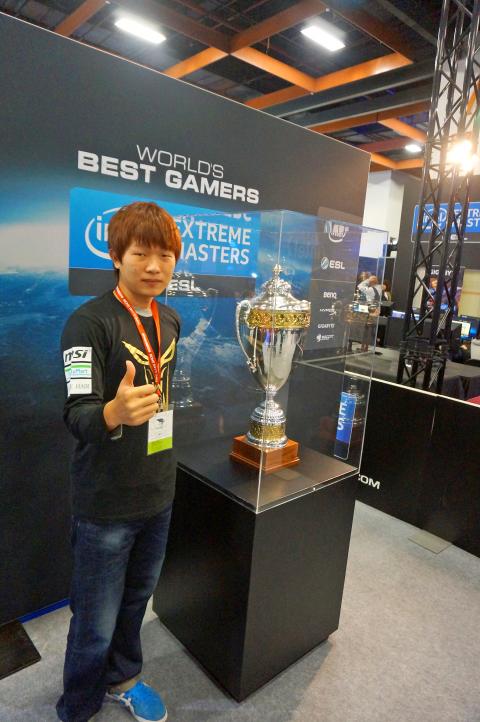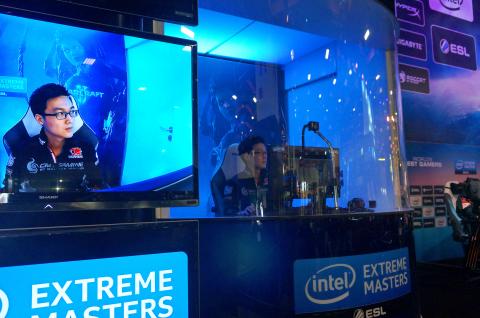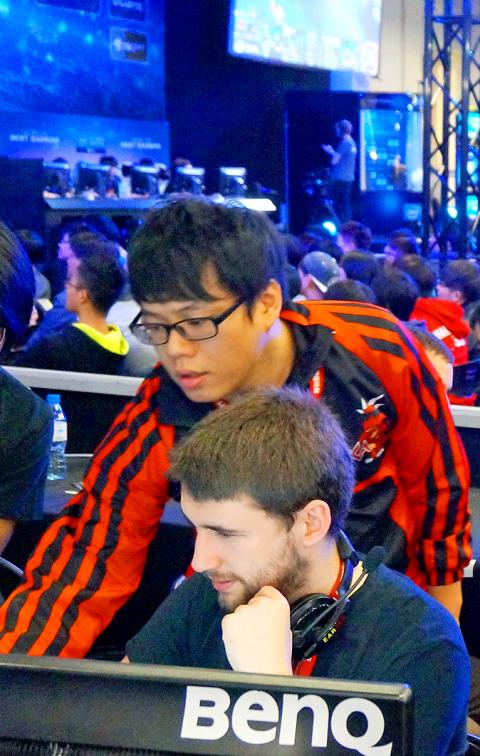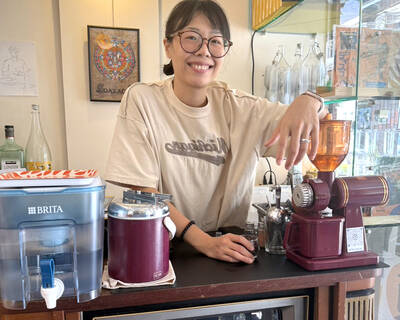Gamer Lu Chia-hung (呂家宏) said he had not read Ender’s Game, or even seen the movie. Perhaps he should.
In Ender’s Game, a boy is unknowingly tasked with wiping out a threat to humanity from a race of bug-like aliens, but among Taiwanese Starcraft II players, the Zerg race — which features “roaches” — is popular, with “Ian,” the name Lu plays under, being one of the nation’s best.
Along with Yang Chia-cheng (楊家正), or “Sen,” and Ke Yu-feng (柯昱夆), or “Has,” Ian represented Taiwan at the Intel Extreme Masters (IEM) esports competition at the Taipei Games Show last week, where the world’s best Starcraft II players took each other on.

Photo: Grant Dexter, Taipei Times
While there is always news about potential Chinese military aggression, IEM is war waged in the virtual world, where South Korea is not only a potential threat — its combatants dominate.
KOREAN DOMINATION
The South Korean players at IEM did as they always do, filling out the main competition with 14 of the 16 spots, while Has and Ian were eliminated before the main draw.

Photo: Grant Dexter, Taipei Times
The only non-Koreans in the top 16 were Sen, who qualified directly as the top local, and Harstem, a 20-year-old Dutchman named Kevin de Koning.
With the real death of two Taiwanese after days-long gaming sessions this year, a typical reaction might be a call for people to quit playing computer games like Starcraft and League of Legends, which also featured at IEM, but the enchantment with gaming is unlikely to fade. Regardless, the question is going to be asked: What legitimacy is there in a career playing computer games for a living?
STUDY THE MOVES

For Ian, it seems e-sports is firmly ingrained as a living first and foremost. Asked if he played any sports, he answered: “Fencing,” seemingly oblivious to the fact he was about to play Patience, a South Korean pro-gamer named Jo Ji-hyun.
Ian said he had prepared well for his opening opponent, who plays as Protoss — a technologically advanced race of beings with psionic powers.
“We all know who we are going up against before the competition, so we usually study their moves,” Ian said. “I know his style of gameplay. I’ll try to go for where he is weakest.”
French commentator Yoan Merlo said he was impressed by Ian’s play, especially his range of tactics.
“He seems to be a very good reactionary Zerg, Merlo said after Ian had taken a two-games-to-one victory. “He adjusted a lot to what Patience was doing, used a lot of different mixes.”
However, Ian met his match going up against Snute, Norwegian Jens Aasgaard — a fellow Zerg — and went out fighting against South Korean Zerg Check, Kim Min-gyu.
Interestingly, the two Taiwanese Zergs picked the Terran race, humans of the future with tanks and stealth helicopters, for a hypothetical defense of their homeland.
“I think the Terran race would be best, because it is the best at defense,” Ian said when asked which race he would pick to defend against a real-life attack from China.
Sen agreed.
“Maybe Terran,” he said. “It is very easy to defend with Terran, because they have tanks and bunkers.”
However, he added that defense is not everything.
“If you want to win, you have to attack,” he said.
Winning a tournament like IEM is going to take a lot more hard work.
“You need a unique play-style, something others do not know about,” Ian said. “It should also be something you have practiced a lot.”
“We need to perform at 100 percent and bring everything [from training] to the table if we are to win against the South Koreans, who have a greater exposure to world-class game play,” he added.
NEW ‘TERRAN’
It seems unfortunate then that there are few Taiwanese Terran players.
“There are few Terran players in Taiwan,” Ian said. “I think there are only two [top-level Terran players] left. One of them is on our team, Vanilla [Chou Yu-ta, 周昱達]. The other one is SpiderHusky’s Chu Hung-hsiang (褚弘祥).”
So why does Ian play Zerg?
“Because I am the best at it,” he joked. “Not really, but I’m slowly adapting. In the past it was about emulating other people. Taiwanese Zerg players usually copy Sen and Sen usually plays defensively.”
“However, I’m not someone who just takes the hits,” he said. “So recently I have changed my tactics. I like to know what my opponent is up to and I then counter it.”
The top players, including Snute, say they travel a lot.
Snute said he was in China, the US or traveling across Europe for competitions a couple of times a month, while Sen said he flew to competitions eight or 10 times a year.
Snute added that Taiwan has a fantastic opportunity to improve, as Taiwanese and South Koreans use the same server, giving local gamers the opportunity to play in the world’s best Starcraft II environment with Internet speeds to make the experience worthwhile.
And does the lifestyle pay off?
“I studied accounting, but I’m not a good student,” Sen said. “As you can see I’m playing games right now.”
However, the final was left to two South Koreans. The only Terran on Sunday to make the quarter-finals, Cho Seong-ju, or Maru, just failed in his attempt to overthrow Lee Seung-hyun, or Life, who took home US$10,000 in prize money.

Cheng Ching-hsiang (鄭青祥) turned a small triangle of concrete jammed between two old shops into a cool little bar called 9dimension. In front of the shop, a steampunk-like structure was welded by himself to serve as a booth where he prepares cocktails. “Yancheng used to be just old people,” he says, “but now young people are coming and creating the New Yancheng.” Around the corner, Yu Hsiu-jao (饒毓琇), opened Tiny Cafe. True to its name, it is the size of a cupboard and serves cold-brewed coffee. “Small shops are so special and have personality,” she says, “people come to Yancheng to find such treasures.” She

The low voter turnout for the referendum on Aug. 23 shows that many Taiwanese are apathetic about nuclear energy, but there are long-term energy stakes involved that the public needs to grasp Taiwan faces an energy trilemma: soaring AI-driven demand, pressure to cut carbon and reliance on fragile fuel imports. But the nuclear referendum on Aug. 23 showed how little this registered with voters, many of whom neither see the long game nor grasp the stakes. Volunteer referendum worker Vivian Chen (陳薇安) put it bluntly: “I’ve seen many people asking what they’re voting for when they arrive to vote. They cast their vote without even doing any research.” Imagine Taiwanese voters invited to a poker table. The bet looked simple — yes or no — yet most never showed. More than two-thirds of those

In July of 1995, a group of local DJs began posting an event flyer around Taipei. It was cheaply photocopied and nearly all in English, with a hand-drawn map on the back and, on the front, a big red hand print alongside one prominent line of text, “Finally… THE PARTY.” The map led to a remote floodplain in Taipei County (now New Taipei City) just across the Tamsui River from Taipei. The organizers got permission from no one. They just drove up in a blue Taiwanese pickup truck, set up a generator, two speakers, two turntables and a mixer. They

Former Chinese Nationalist Party (KMT) chairwoman Hung Hsiu-chu’s (洪秀柱) attendance at the Chinese Communist Party’s (CPP) “Chinese People’s War of Resistance Against Japanese Aggression and the World Anti-Fascist War” parade in Beijing is infuriating, embarrassing and insulting to nearly everyone in Taiwan, and Taiwan’s friends and allies. She is also ripping off bandages and pouring salt into old wounds. In the process she managed to tie both the KMT and the Democratic Progressive Party (DPP) into uncomfortable knots. The KMT continues to honor their heroic fighters, who defended China against the invading Japanese Empire, which inflicted unimaginable horrors on the